You've probably heard about push notifications and dealt with them yourself more than once, right? But did you know they can serve as an excellent marketing tool to increase the profitability of your mobile app? Yes, don't be surprised, that's the way they work!
Believe it or not, notifications are a cool channel of instant communication with your users, which allows you to engage them in active interaction with your platform. To be precise, each of your users will be aware of your latest news, special promotions, application updates, and more. Plus, you'll be able to remind the consumer that he or she hasn't opened your app for a long time.
Interesting, isn't it? Then we suggest reading our new article. We're going to explain to you the operating principle of notifications, describe their advantages, share a few approaches to convincing a user to subscribe to your push messages, and the like.
Push Notifications: Basics to Know
A push notification is a short message displayed by an application on a server command. The greatest thing is that the user may not even be working with the mobile program at this exact moment! You’ll have an opportunity to reach him or her whenever you want.
Why is push technology so good?
-
it provides the user with targeted, relevant information at the right time;
-
the OS of the device maintains a constant background connection with the server, which means there is real-time interaction with the user at any time of the day, anywhere in the world;
-
push-technology doesn’t overload the device memory and doesn’t drain the battery.
What Does a Typical Push Notification Consist Of?
-
header. And you need to come up with something bright, original: why not use emoticons and cool emoji?
-
visual component, namely, a picture, the purpose of which is to attract the user's attention;
-
text: the push message itself with information to convey to the user;
-
a link to the application screen corresponding to the transmitted message.
History of Push Messages
Initially, push technology was invented at the very beginning of the 21st century (to be specific, in 2003). The idea came from Research in Motion, which was looking for a real-time email solution so that Blackberry device users could receive emails without delay, on the go.
As to iOS and Android mobile platforms, the first example of a push notification was proposed by Apple in the summer of 2009 (iOS 3.0). Google also kept up with the competitor and created GCM and FCM (as opposed to Apple's APNS). And in 2014, web push messages appeared.
Today, push notifications features are implemented in devices of Google Android, Apple iOS, Amazon Echo, Huawei Android, Windows, and so on.
Push Notifications Statistics
-
The average user receives 45-50 push notifications to his smartphone every day;
-
The peak user engagement is observed from 6 to 8 pm on weekdays: it is at this time that we are used to opening notifications. And the most active interaction with notifications usually occurs on Tuesdays;
-
Users subscribe to push notifications three times more often than to email newsletters. Moreover, the click-through rate of push messages is 7 times higher than that of email letters.
-
Notifications mentioning a user by name are opened 10% more actively.
-
With the correct push notification settings, you can expect 45+ % of transitions to a resource, be it a website or an application;
-
According to statistics, the main push notifications functions include:
-
notifying the user about the release of app updates (more than 40%);
-
special offers (almost 25%);
-
announcement of new content (next to 15%);
-
advertising links (10+ %).
-
Types of Push Notifications
When implementing pushes, you need to understand their essence; you have to know what you'll have to face and deal with.
Let's get this sorted out.
Content notifications
The simplest use of push notifications is to tell the client about what is happening in your application (and the story should be interesting to him).
For example, an mCommerce app can inform on upcoming sales, promotions, etc;
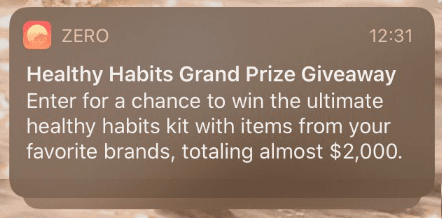
Zero invites the user to win a prize: he just needs to return to the app and follow a series of simple actions.
A trigger approach to push notification mechanisms
Among others, you can (and should) inform the user about events related to him and his life. Here are a couple of relevant ideas of the sort:
-
greeting the returning user;
-
abandoned shopping cart reminder;
-
notification about the actions of other users from his environment (let's say Instagram often tells the user that a particular friend recently made a new post or published a story);
-
informing on received new messages, etc.

Transactional push messages
Here we’re dealing with business-type notifications, which inform the user about the order status (or something similar):
-
proof of payment;
-
change of order status;
-
the appearance of goods in the warehouse;
-
and so on!

What is the Difference Between Push Notifications on iOS and Android?
All notifications are the same in their architecture and principle of operation, but there are still some differences. Let's list them briefly.
-
Swipes:
-
if you're a user of iOS devices, you can open the notification not only by tapping it but also by swiping to the right (while swiping to the left offers several actions to choose from);
-
on the other hand, Android users know that swiping to the right and left closes the notification.
-
-
Default conditions:
-
In the case of Android devices, push notifications come by default, so the subscription rate is very high and reaches 91.1% (after all, the subscription is automatic!);
-
if we’re discussing the iOS platform, then the situation is somewhat different: by default, notifications are blocked, and subscribing to them requires user confirmation. And the percentage of subscriptions is correspondingly lower than for Android programs: about 44%. Therefore, iOS users are less likely to open a notification... but if they do open it, then more deliberately. This means there is a better chance of converting iOS users into real customers.
-
-
Grouping push messages:
-
In iOS 12 and above, notifications are grouped by application and time, which greatly improved the user experience.
-
In Android, notifications can also be grouped, but the approach to grouping is not always clear and sometimes lacks logic.
-
-
Push notification settings:
-
Each iOS application involves a lot of work on setting up notifications, such as the choice of a sound signal. There are basically 3 options for displaying push notifications on iOS:
-
Audio – informing on a new notification (using a sound signal);
-
Audio/Banners, when a banner appears on the smartphone screen, accompanied by a sound signal;
-
Badges, when a special icon with a figure indicating the number of notifications appears in the upper right corner of the application icon.
-
-
In the case of Android programs, everything is much more complicated, since Google's platform is quite flexible. Among other things, there is no built-in system for displaying push notifications, so it's all up to the developer. As he (a developer) wants (and programs), so it shall be. This is how the Android push notifications mechanism works.
-
Now it’s high time to discuss the advantages of push messages.
Key Advantages of Push Notifications
-
Capturing user attention. Push messages appear on the smartphone screen even if the user has already closed your application (or didn't open it at all today). This way you grab the user's attention and remind him or her of your program.
-
Easier and better user interaction, which includes:
-
simplified process of subscribing to notifications (just one touch, and the user is subscribed);
-
the ability to communicate with the user regardless of his interaction with your mobile service (which we’ve already mentioned in the first item).
-
-
Effective conversion of users into customers. Push notifications help return the user to the application, which increases conversion and reactivates inactive subscribers.
-
User contact data security. When a user subscribes to an email newsletter, he provides the company with his email address (obviously!). However, push notifications functions don't depend on contact information, which means the user feels safe and more readily agrees to work with you. You’ll find out everything you need later when the user starts to trust you.
-
Increased and improved traffic. Using push notifications features, you can direct the customer to a specific app screen (the one you promote).
Okay, that's all very well, but how do push notifications work?
Basic Mechanisms for Push Notifications
We'd like to start by describing the general principle of operation of push notifications on iOS and Android:
-
Of course, any application must first be installed on a mobile device.
-
Now the OS registers the app on the required server: GCM / FCM (Android), APNS (iOS), MPNS (Windows Phone) and receives a token, which is the device ID. Consider a token as an address for sending push notifications.
-
The application gets a token and sends it to the server to organize further work with push notifications.
-
Then everything is simple: if the conditions defined by the app developer match, the server sends a push notification using a token. These conditions may differ, and we described them earlier (promotional offer, reminding the user about his long-term non-opening of your program, etc.).
Sometimes an intermediate service is additionally used to check the relevance of the token (since the application can be reinstalled or uninstalled).
Why is the relevance check important?
Let's say a user has uninstalled an app from one of his devices. It is logical to assume that the push notification provider will transmit information that notifications should no longer be sent to this very device. Right?
However, GCM (Android push notification server) will send the required token immediately, and APNS (Apple's service) will resort to a separate feedback server, on which the list of tokens is being accumulated and sending once a day. So the intermediate service will come in handy in such a case.
iOS Push Notifications Mechanisms
APNS stands for Apple Push Notification Service and is the cloud platform of the iOS system. It allows sending iOS push notifications.
iOS push notification mechanisms are extremely simple and echo what we described above. The infographic below illustrates the whole process very clearly:
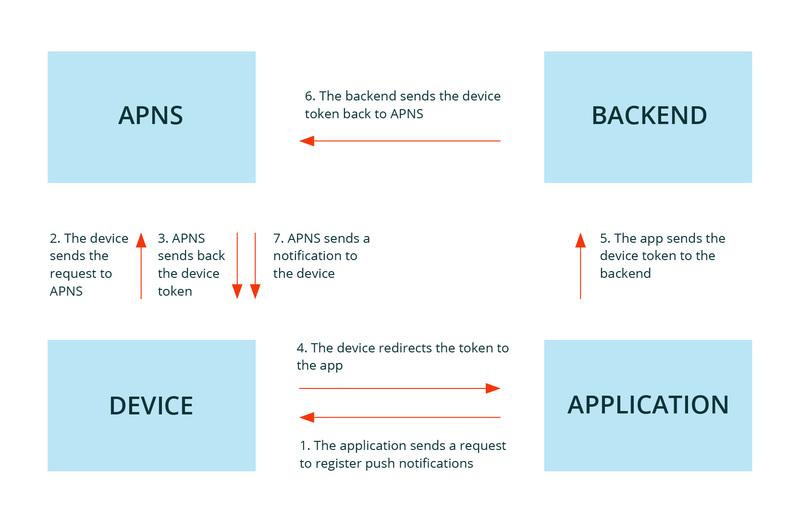
Android Push Notifications Mechanisms
If we talk about the push notification solution from Android, then there are several options:
-
The easiest way to act is to use Firebase Cloud Messaging (for Android devices with Google Apps).
-
If your users have Huawei devices (namely, without Google Apps), you should resort to the Huawei Push Kit.
-
Of course, you can also create your own push notification provider or use ready-made projects, since the platform is open-source.
What is FCM?
Firebase Cloud Messaging is a new and improved version of GCM, which is Google Cloud Messaging. It is free and highly flexible.
As we’ve already said, Android notifications will be displayed on the user's smartphone the way the developer wants. That is, push notifications features (and their method of displaying) depend on who creates the application.
Cross-Platform Mechanisms for Push Notifications
If your application runs on just one platform, then everything is relatively simple... but what if your mobile service supports both iOS and Android devices? Do you really have to configure notifications for each OS separately? Is there no way to make such a tedious process easier?
Let us put your mind at rest: the above-mentioned Firebase Cloud Messaging from Google can help organize sending notifications to all types of devices: Android and iOS ones; moreover, it also works with web notifications! The only exception is the Huawei platform (in this case, you have to deal with the Huawei Push Kit).
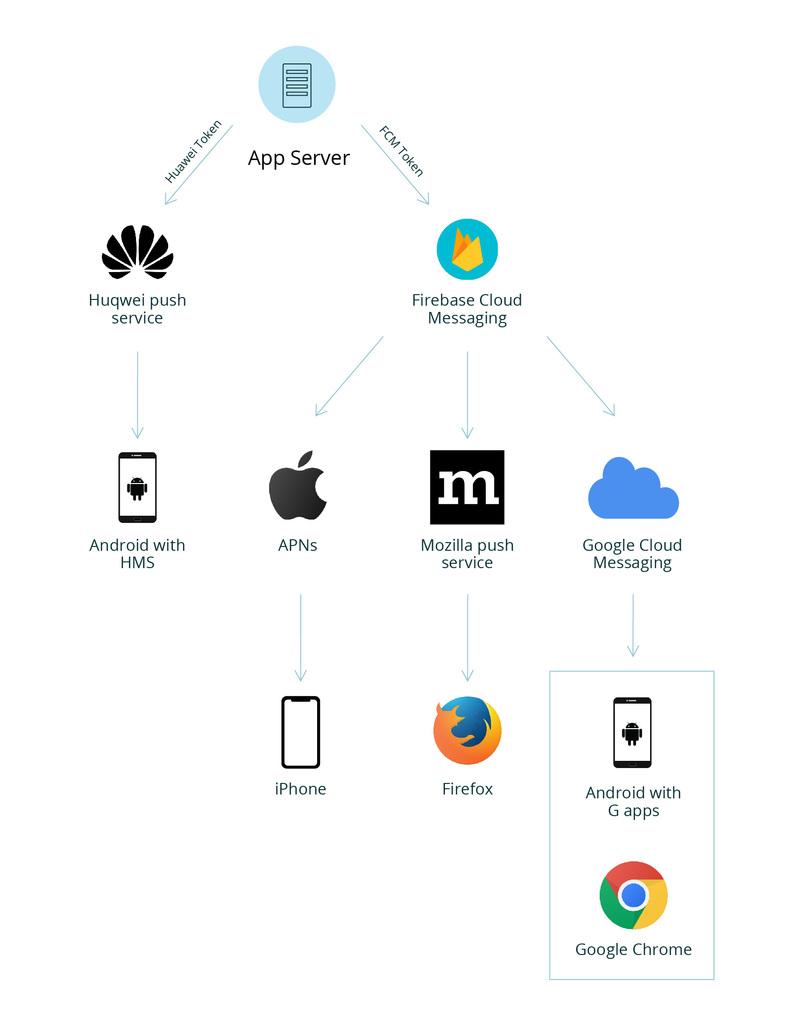
The Main Mistakes When Implementing Pushes
-
Obtrusiveness from the first moments. The user hasn't yet figured out what kind of application this is, and you’re already asking him to subscribe to notifications! There is something to get annoyed about, right?
-
Too many push messages. If a user receives one notification after another within the same day, he’ll definitely get furious and delete your application altogether.
-
Lack of specifics. "Subscribe to notifications!" - you ask the user... and you do wrong! You need to explain to the user what exactly you are suggesting him to subscribe to.
-
Irrelevant content. You'll completely cancel the advantages of push messages if you provide the user with irrelevant information.
User Permission Requests
How to get a user to subscribe to your notifications? There are 2 main ways to achieve the goal:
-
A system-defined method, which is the simplest, even primitive, way to get user consent to receive your notifications. Simply stated, you offer the user to subscribe to push messages from the very first moments. As we wrote above, this way of interacting with the target audience is extremely ineffective. The chance of getting rejected is really high.
-
Explanatory method. In other words, you don't beg the user to subscribe to notifications, you explain to him why he should do it (you describe the advantages of push notifications to him). As the statistics show, such an approach leads to an increase in the number of positive responses from 40% to 66%.
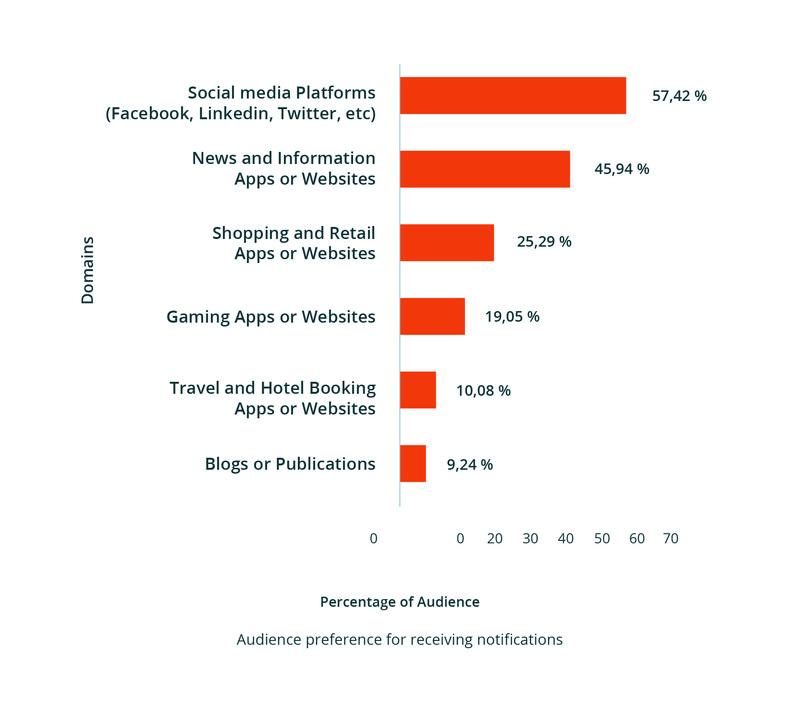
By the by, there is one little trick to help you win a greater number of notification subscribers... even against their will. Let's discuss?
How to play hanky-panky with a user?
A good way to cheat a little is to prompt the user 2 options: he can either agree to receive notifications right now or postpone the decision until later. So if the user refuses to be your subscriber today, you’ll get another attempt to convince him after a while.
How to Plan a Push Notification Strategy?
We've discussed the push notifications functions and mistakes you should avoid making. Now it's time to describe the basic strategy itself.
User base collection
The first stage is collecting a database of people who have agreed to receive your notifications. We've already explained how you can get their consent to subscribe.
Action planning
You now have users who have subscribed to your push messages. But what should they be informed on? How often do you need to provide them with relevant data? All this is worth thinking about at the second stage of your strategy formation:
-
Frequency of notifications.
-
Sometimes it's good to remind the user of a particular event several times, but moderation is vital. After the 6th message per day, users stop tapping and viewing push notifications (statistics data).
-
-
Time of notifications.
-
In this respect, the nature of the message you plan to convey to the user is important. The logic is clear: you need to choose the time period during which the user is most willing to accept your information.
-
Also, keep in mind the following: according to statistics, notifications are usually sent during the working day, while smartphone owners open them in the evening, after 6 pm (which we’ve mentioned earlier, as you might recall).
-
-
The relevance of notifications.
-
The topic of relevance can take ages. It's about the personalization of push notifications, the timeliness of the information provided (why report a New Year sale in the spring?), etc. (continue the list yourself).
-
Analysis of results
Of course, it's also important to check how effective your strategy has been. What if it needs improvement?
How to evaluate the results of the notification strategy?
We suggest focusing on the main indicators of efficiency:
-
CTR (Click-Through-Rate), the ratio of the number of clicks on a push notification to the number of impressions.
-
opening ratio: who opened the notification and read it?
-
conversion rate: the percentage of users who opened the app after receiving a notification.
By the way, some people prefer to evaluate negative results and analyze the number of users who have unsubscribed or even deleted the application after a certain notification. In the end, this is a clear hint that your strategy has completely failed!
How to Avoid Unsubscribing From Notifications?
To understand how to avoid the sad outcome of unsubscribing users from your push messages, you should analyze the statistics data. There is no need to do the analysis yourself, there are companies, which have already done this. For instance, VWO Engage conducted a survey and found that most users opt out of notifications when receiving too many of them (more than 60% of unsubscribed users) or if they're not interested in the information provided (about 55% of unsubscriptions).
To get all the data, take a look at the infographics below.
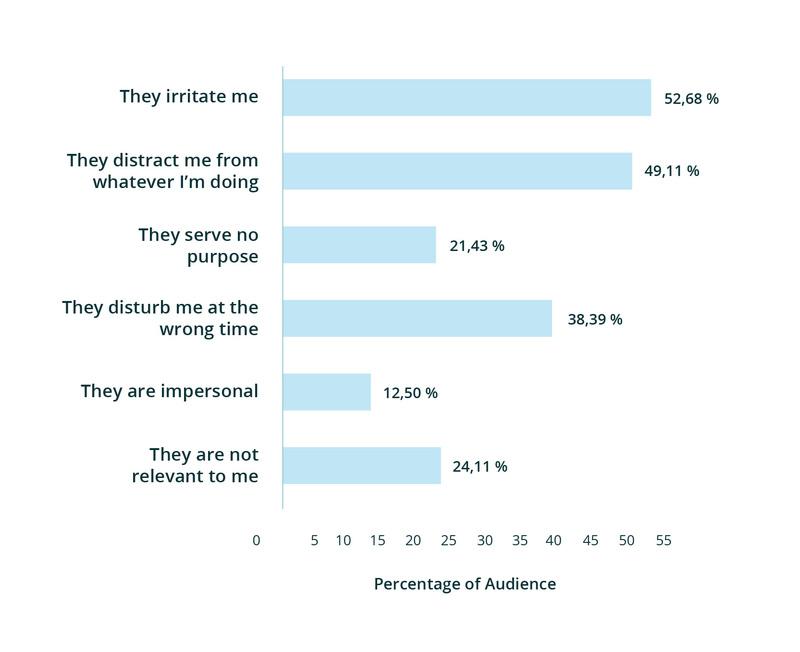
P.S.
Almost 10% of people turn off notifications if they get the same information every week. So use the advantages of push messages wisely.

